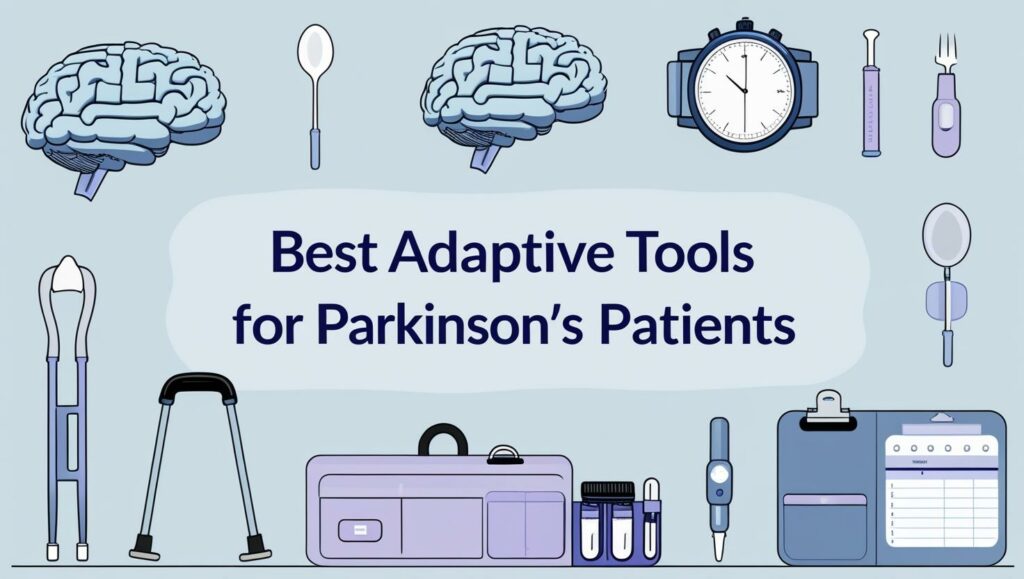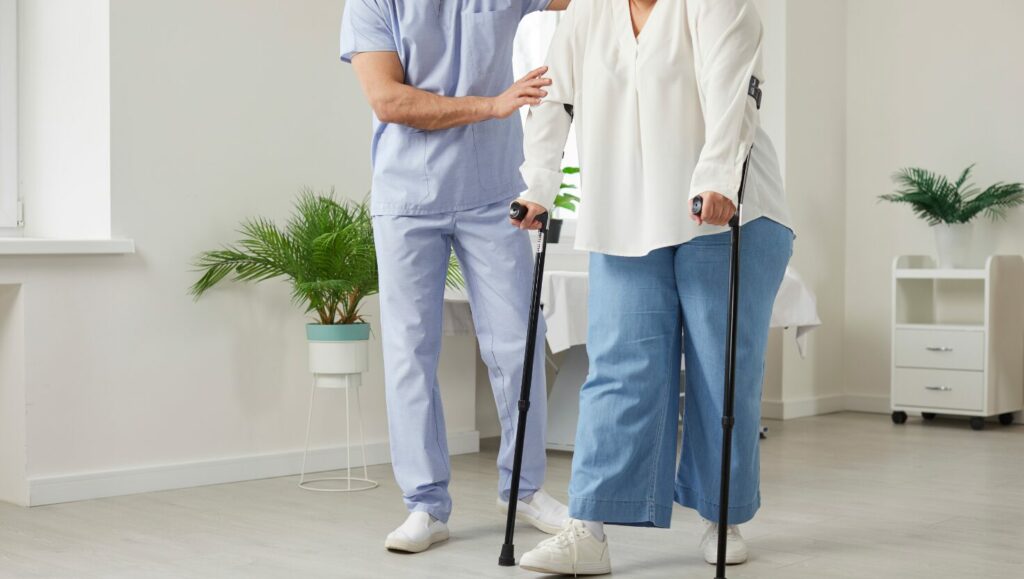Living with Parkinson’s disease presents daily challenges—but the right adaptive tools can make a world of difference. Whether it’s mobility, eating, speaking, or self-care, technology and practical gadgets have evolved dramatically in 2025 to support independence and dignity.
This updated guide includes real tools people with Parkinson’s disease are using and recommending right now, backed by research studies, therapist advice, and expert sources.

Adaptive tools are specially designed gadgets or technologies that help Parkinson’s patients overcome movement, speech, or daily activity limitations. These include:
- Walkers with visual cueing
- Adaptive utensils and kitchen aids
- Wearable speech enhancers
- Smart insoles and activity monitors
- Augmented reality gait trainers
- Dressing and grooming support
These tools help reduce fall risk, promote independence, and improve quality of life, especially as symptoms progress.
This guide was compiled using real discussions from:
- Parkinson’s Reddit community and Facebook support groups
- Research studies published in reputable journals
- Leading sources like Parkinson.org, Michael J. Fox Foundation, and Davis Phinney Foundation
- 2025 tech reviews and FDA device updates
''Affiliate Disclosure: This page contains affiliate links, and while it may not cost you anything extra, if you make a purchase through these links, We’ll earn a small commission''.
Parkinson’s tools that are new in 2025 and backed by research studies
Adaptive deep brain stimulation (aDBS) — A game-changer in 2025

Best for: improving motor symptoms in advanced Parkinson’s patients
Adaptive DBS, also known as BrainSense Adaptive DBS (by Medtronic), is the first closed-loop neurostimulation system approved for Parkinson’s disease. Unlike traditional DBS, which delivers continuous, pre-programmed stimulation, aDBS senses the brain’s local field potentials (LFPs)—specifically pathological beta-band oscillations—and adjusts electrical pulses in real-time based on the patient’s neural activity. Think of it like a smart pacemaker for the brain: it responds dynamically to shifting symptoms rather than sticking to a fixed setting.
This therapy is intended for patients with advanced Parkinson’s disease whose symptoms—such as tremor, rigidity, or dyskinesia—are not fully controlled by medication or conventional DBS. Candidates must already have a Medtronic Percept™ neurostimulator implanted and meet the eligibility criteria defined by specialists
Real results from research & early Use
- A pivotal global clinical trial (ADAPT‑PD) demonstrated that aDBS significantly improves motor symptom control, optimizes stimulation settings faster, and reduces side effects compared to continuous DBS.
- FDA approval in February 2025 was based on positive evidence showing reduced dyskinesia, fewer medication doses, and enhanced quality of life in real-world patients, like those treated at UCSF and Stanford—some resumed activities they thought were lost, such as running and playing music
Related post: What is Adaptive Deep Brain Stimulation and How it Helps Parkinson’s Patients
Cueing & rehab tools – innovative tools in 2025

Best for: Improving walking rhythm, freezing episodes, and home-based exercises
The biggest innovation in 2025 is how technology-driven solutions have become more immersive, wearable, and accessible, making physical therapy easier to maintain at home. Cueing and rehab tools are essential for Parkinson’s patients, especially those who struggle with freezing of gait, irregular step timing, or reduced motivation to exercise. These tools use external stimuli—visual, auditory, or interactive—to help retrain the brain and improve motor function. These tools not only support physical rehabilitation but also make movement more engaging, structured, and less frustrating, helping patients build consistency over time.
AR gait cueing with stroll
This cutting-edge augmented reality headset (worn like glasses) overlays virtual floor patterns—like lines, arrows, or stepping targets—onto the real world. These visual cues act as stepping guides, helping the brain overcome freezing episodes by providing a consistent external rhythm. Patients report feeling more confident when walking indoors and outdoors, particularly in areas where freezing tends to occur (doorways, tight corners, etc.). Strolll is especially praised for making cueing discreet and wearable—ideal for people who want tech that doesn’t call attention to their condition.
Get Your Free Parkinson’s Medication Management Diary
Download your free printable diary to easily track your medications, symptoms, and doses.
A 2025 randomized controlled trial involving 100 participants with Parkinson’s disease evaluated the feasibility and effectiveness of Strolll AR, an augmented‑reality system offering gamified gait and balance exercises—both in-clinic and at home participants used AR cueing during structured walking and balance activities over a 6‑week in-clinic familiarization followed by 6‑weeks of at-home therapy, with outcomes measured for gait, balance, and fall risk before and after the intervention. Early results suggest high adherence, safety, and promising improvements in gait performance and balance metrics—supporting the real-world use of tech‐driven cueing as part of Parkinson’s rehabilitation.
Devices like the Varjo XR‑3 and Meta Quest 3 offer powerful mixed-reality features that support visual cueing therapy—an evidence-based approach shown to reduce freezing of gait and improve walking rhythm in Parkinson’s patients.
Key benefit: Delivers real-time, dynamic visual cues without needing handheld devices.
VR exercise platforms (Oculus FitXR, NeuroVR)
Virtual reality (VR) platforms like Oculus FitXR or NeuroVR turn traditional rehabilitation into an interactive, game-like experience. These systems offer guided balance training, aerobic routines, and movement games that help improve motor control, posture, and cognitive function. The immersive environment helps reduce the boredom and resistance many patients feel toward traditional rehab exercises. Many clinicians are now recommending these platforms for home use to complement physical therapy sessions.
A pilot study of 32 individuals with mild-to-moderate Parkinson’s disease demonstrated that a wearable VR headset (e.g., Oculus Quest 2) paired with a boxing-style exergame was safe, usable (System Usability Score ≈ 75/100), and highly satisfying—88% of participants rated the experience as “good” or “very good”.
Over a total of 60 sessions, there were no adverse effects reported via the Simulator Sickness Questionnaire, and the Game Experience Questionnaire scores were notably low for negative experiences, suggesting VR’s suitability for older patients with Parkinson’s disease.
These findings reinforce that interactive VR rehabilitation can be both accessible and engaging, supporting everyday mobility and motivation in Parkinson’s therapy.
Check out Meta Quest Pro + FitXR on Amazon
Key benefit: Makes exercise enjoyable and motivating while delivering functional rehab gains.
Metronome & auditory cueing apps
Apps like BeatWalk, ParkiGait, or simple metronome tools provide rhythmic auditory cues that help regulate walking cadence and reduce freezing. The beats act as an external pacing mechanism, helping the brain synchronize movement with sound. These apps are easy to use, affordable, and highly customizable, with options to adjust tempo and sync with personal walking speed. They’re especially helpful for patients in earlier stages of Parkinson’s or those managing freezing without physical assistive devices.
In a one-month outdoor gait rehabilitation study involving 45 Parkinson’s patients, the BeatWalk app synchronized music tempo to each user’s walking cadence, gradually increasing pace by up to 10% to enhance exercise duration and gait confidence. Participants completed around 79% of prescribed sessions, reported high usability (75%) and enjoyment, while pain and fatigue did not increase. After the program, walkers improved six-minute test performance even without music, and participants experienced reduced fear of falling and better quality of life.
Key benefit: Portable and simple way to improve step timing and walking fluidity using only a smartphone or headphones.
Top mobility & walking aids in 2025

Best for: Freezing of gait, tremors, and balance difficulties
Mobility tools are critical for people with Parkinson’s disease, as they directly address challenges like freezing episodes, instability, and rigidity. These devices not only improve safety but also empower users to move with confidence and independence.
U‑Step Neuro walker
Designed specifically for Parkinson’s disease and other neurological conditions, this walker features a patented U‑shaped base for maximum stability, reversed braking control (which prevents unwanted movement), and an optional laser & sound cueing module that projects a visual or auditory rhythm to combat freezing episodes. Widely recommended by therapists and often covered by insurance due to its proven benefit in reducing falls and improving stride length.
Laser cane
This specialized cane emits a bright laser line just a few inches ahead of the feet—creating a visual stepping target that helps users overcome freezing of gait. Many patients describe it as giving their brain a “cue to move,” making it especially useful for those in early to mid-stages of Parkinson’s disease.
Smart walking stick
Smart walking stick is a modern upgrade from traditional canes—designed with built-in safety and monitoring technology tailored to neurological conditions like Parkinson’s. The stick comes equipped with fall detection, GPS tracking, emergency alerts, vibration cueing, and even health monitoring sensors. These features are especially helpful for those in early to mid stages who still walk independently but need support, safety, and on-the-go reassurance.
The Alinker walking bike
A three‑wheeled, pedal‑free device designed for upright, active mobility. Users with Parkinson’s disease report being able to walk longer distances, reduce leg strain, and maintain causal posture, especially helpful for those who still have some leg strength. Its foldable design and adjustable seat make it suitable for diverse living environments, and its distinctive look promotes social interaction.
Get Your Free Parkinson’s Medication Management Diary
Download your free printable diary to easily track your medications, symptoms, and doses.
Adaptive utensils & kitchen aids that still matter in 2025

Best for: Hand tremors, limited grip strength, poor coordination, and mealtime independence.
Durable adaptive utensils and cups remain useful aids for people with Parkinson’s disease, even in 2025.
Weighted utensils & built-up grips
Weighted cutlery provides stability by adding mass to the handle, helping reduce tremor-related shaking when eating. Many users say these utensils—like stainless steel sets with built-up grips—improve control and reduce spills, making meals simpler and less frustrating. Medically reviewed sources emphasize their ongoing value in Parkinson’s care for preserving independence at mealtimes.
Related post: Best Weighted Utensils for Parkinson’s Patients – Detailed Reviews and Selection Tips
Adaptive drinking cup – handSteady mug
The HandSteadys drinking Cup features a patented rotating handle and a hidden lid that self-level to counteract tremors—reducing spills and enabling comfortable drinking without wrist strain. It’s lightweight, durable, and widely recommended by healthcare providers and users with tremor-related conditions including Parkinson’s disease.
Rocker knives & plate guards
Rocker knives have a curved blade on top that allows scooping without wrist twisting—ideal for tremor-limited coordination. Plate guards gently edge regular plates, guiding food onto utensils and minimizing mess. These accessories are repeatedly highlighted by therapists and caregivers as simple yet profound tools for meal independence
Supportive daily aids that still matter in 2025

Best for: Dressing, bathing, walking, grooming independently
Daily living & dressing aids
Everyday tasks like dressing, personal hygiene, or bathing can become challenging for Parkinson’s patients due to tremors, stiffness, and coordination changes. Smart adaptive tools remove frustration, support consistency, and help maintain dignity and self-reliance.
Button hooks, velcro shoes & slip-on Clothing
Adaptive toolkits like button hooks, zipper pulls, and sock aids allow users to dress without relying on fine finger dexterity. Slip-on shoes or those with Velcro closures and elastic laces help reduce bending and secure footwear safely. Many adaptive clothing brands now feature magnetic closures and pull-down backs to simplify dressing while seated.
Related post: The Best House Shoes for Parkinson’s Patients – A Practical Guide
Long-handled sponges, toothpaste dispensers & electric razors
Long-handled sponges and bath brushes extend reach without compromising balance during showering. Simple tools like wall-mounted toothpaste dispensers or electric razors ease grooming tasks for those with diminished grip or shaky hands. These assistive devices are frequently recommended by occupational therapists to support safe and independent self-care.
Advice for choosing the right tools
- Work with OT/PT professionals to identify tools based on stage and needs.
- Engage with support communities—they offer unfiltered feedback on practicality and real-life performance.
- Consider insurance coverage or assistance programs, especially for devices like SpeechVive or adaptive DBS.
- Start small and trial tools—often inexpensive adaptations (e.g., utensil grips) can have immediate impact.
Final thought
If you or a loved one are living with Parkinson’s, the right tools can make a meaningful difference — not just in mobility or daily tasks, but in overall confidence and quality of life. From advanced therapies like adaptive DBS to simple kitchen aids and smart wearables, today’s technology offers more support than ever before.
Explore the tools mentioned in this guide, and speak with your healthcare provider, physiotherapist, or occupational therapist to find the options that best suit your needs and goals.
Get Your Free Parkinson’s Medication Management Diary
Download your free printable diary to easily track your medications, symptoms, and doses.

September 2025
My husband has known he has Parkinson’s since 2016. Where can we find some of the items you wrote about? He has a Walker and a cane but forgets to use them much of the time in the house. At some stores he pushes a shopping buggy. One of our problems is when we are out from home we get too tired and have to return home.
We are both 86 years old and it gets hard to keep going when we can’t see any kind of a good future.
Thank you for sharing so openly. It sounds like both of you have been managing a lot with strength. Many Parkinson’s foundations and local support groups offer guides and lists of helpful daily-living tools, and occupational therapists can suggest practical items to make life at home and outside easier. Feeling tired more quickly is common, so pacing activities, planning shorter outings, and building in rest breaks can help. You’re not alone—connecting with Parkinson’s support communities can provide both practical tips and encouragement for the road ahead.